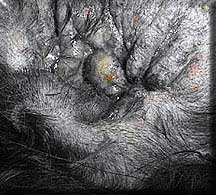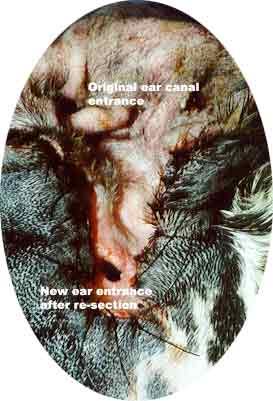 |
|
||||||||||||
|
Shar pei Lateral Ear |
|||||||||||||
|
Due to the
'desirability' of smaller and smaller ears in the breed there are
increasing ear problems in Shar pei, some of which may require
surgical intervention to relieve. Some dogs have a
natural predisposition for ear trouble, West Highland White
Terriers, Poodles and the modern Sharpei are good examples of such breeds, they have narrow
ear canals with hair in them, this obstructs air flow and causes moist
warm conditions in the bottom of the ear canal which are ideal for
bacterial and fungal growth, this is worsened in Shar-pei with narrow ear
canals, by the closed fold of the ear flap. How are the common ear diseases treated? Ear mites are easy to see as they are clearly visible under the low magnification of the otoscope and crawl about, sometimes in large numbers, the ear mite products are usually very effective. Foreign objects such as grass seeds etc, are easy to see as well, but removal may involve an anaesthetic, once removed though the problem is over. It is often difficult to differentiate between fungal infections and bacterial infections, but some of the common ear products will treat both conditions, so they are generally the front line approach. Bacterial and fungal infection may become chronic and difficult to treat so if the first treatment does not work it is often prudent to send samples away to identify the causal organism and work out which would be the most effective treatment.
A culture of the discharge from the ear is frequently used to help your vet determine what bacteria or fungus is causing the problem. Since many organisims are usually grown in a culture, and some of them are normal inhabitants, this test is not always advantageous. .. Some bacteria which live in ears are now very resistant to common antibiotics so it is always best to work out what is going on in cases of long standing ear disease. If the problem is still present after this stage then an ear syringe often helps, this is carried out under deep sedation or light anaesthetic and involves gently floating out all the debris in the ear canal then packing it out with antibiotic or antifungal ointment... A
culture that may grow out 3 different bacteria that are common to find in
the ear canal. (Pseudomonas) is resistant to all the antibiotics that are
commonly tested… Culturing the bacteria is simply getting it to grow on a culture plate from a swab or from a tissue. Sensitivity testing involves exposing the cultured bacteria to a number of antibiotics to see which ones kill it on the culture plate at concentrations likely to be present in the blood stream. An antibiotic chosen by culture and sensitivity has a good chance of working well if it also penetrates the tissue that is infected in a reliable manner. A major breakthrough was the development of the fluoroquinolone class of antibiotics (including Enrofloxacin, its counterpart for human use ciprofloxacin, and several others). These medications are active against many bacterial types including Pseudomonas. They are available as tablets ( BAYTRIL) and may be used in either dogs or cats to combat different types of infections, especially those involving Pseudomonas. Enrofloxacin is also active against Staphylococci, and thus is commonly used for infections of the skin. Enrofloxacin has toxic properties in humans. It is for veterinary use only Dogs with Pseudomonas ear infections require very high doses of enrofloxacin and nausea may become a problem. In immature dogs (less than 8 months of age) damage to joint cartilage can occur. This phenomenon is only seen in growing dogs ...
SOME
IMPORTANT INFORMATION ON PSEUDOMONAS INFECTION If lucky, a culture of the ear discharge will reveal that the Pseudomonas is still sensitive to oral quinolone antibiotics such as Enrofloxacin or Orbifloxacin. It should be noted that especially high doses of this type of antibiotic are needed to treat Pseudomonas in the ear and that inadequate dosing will just make Pseudomonas even more resistant... Pseudomonas must be treated definitively from the moment it is diagnosed; once it becomes resistant to oral therapy, treatment becomes vastly more difficult...
Oral therapy is generally combined with some kind of topical treatment
of the ear. Fortunately there are several concoctions that should be
useful though some your vet must mix him/herself...
Can ear disease be prevented? probably not, the best thing would be to consult your vet at the first sign of trouble, this would be when your dog’s ear is obviously smelly, sore or itchy or if there is any sign of ear discharge. If you have more than one dog, and one is constantly licking the others ear,or both are licking each others ear's constantly this is a sign of ear infection...Take your Pei to the Vet... |
|||||||||||||
|
|
|||||||||||||
|
Site Researched and Produced by ©Kavishi Shar-Pei |
|||||||||||||




